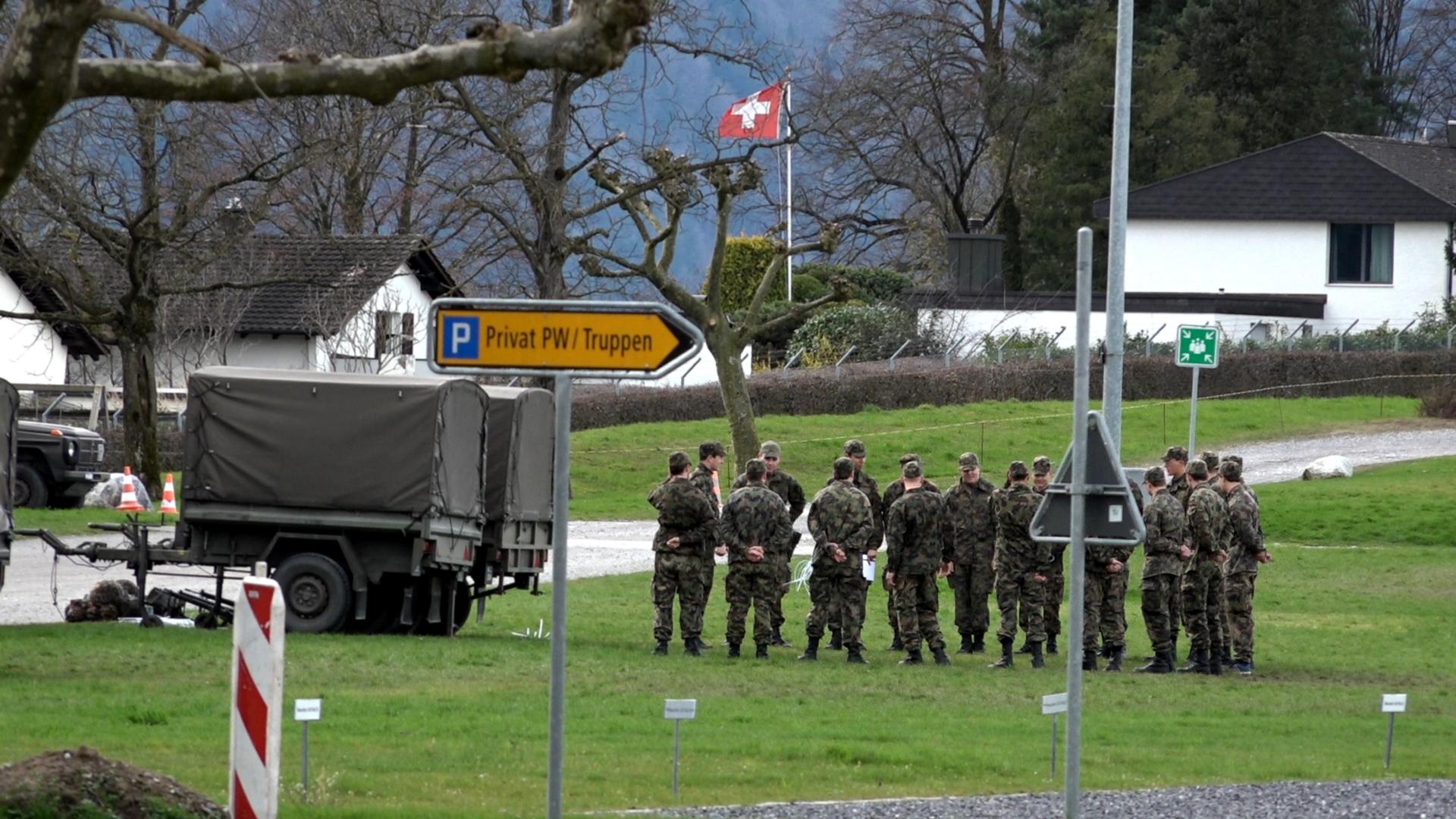Calls for women’s army service fall on deaf ears

When high-ranking defence officials backed recruiting more women to the Swiss army, possibly through conscription, people sat up and took note. But public opinion and practical realities mean it’s easier said than done.
Earlier this year, Brigadier General Denis Froidevaux made headlines when he said in a newspaper interview that he would support requiring women to serve in the military. And in March, Swiss Defence Minister Ueli Maurer took to the floor of parliament amid discussions on how to modernise military service to argue that women would “motivate the troops” if more of them went into the army.
But then, there are the numbers: 170,553 people serve in Switzerland’s militia army. Out of those, just 1061 – or 0.6% – are female.
That makes women in uniform a minority to the point of exoticism, and it’s a reality that Lieutenant Mona Kräuchi lives every day.
“You have to be aware that you’re going to stick out,” the 21-year-old platoon leader and anti-aircraft weapons specialist tells swissinfo.ch. She speaks a bit nervously at first but warms up when recalling challenges overcome with her fellow soldiers, like completing the physical test of walking 100 kilometres at a time. “People always come up to me in public, at train stations, and ask how I got into this line of work. But they’re not critical of my choice – just curious.”

More
A woman and a platoon leader
Curiosity also drove a group of five young women from the same school to attend a recent army orientation day for new recruits from the canton of Bern. Special places are saved for them at the front of the room, and before the day starts they’re taken aside to make sure they understand that, unlike the young men seated behind them, they are free to choose their level of involvement and role in the military.
All Swiss women receive a letter at age 18 letting them know that they are welcome to join the army if they wish. They have been able to serve alongside men since 1995 and all roles have been open to them since 2004.
At the military orientation day, the five women’s levels of interest in actually serving in the army vary widely: one is attracted to learning to use weapons, another is more interested in civil or social service opportunities. A few seriously question the need for the army but want to see what their male friends have been talking (and complaining) about since turning 18. But none believe that female conscription is the way forward for Switzerland.
“If I were to join the military I would do it for a personal challenge, to learn my own physical and psychological limits,” says 18-year-old Adchara Supiramaniam. She’s the one who rallied her friends to take part in the orientation day, wanting to learn more about how the army works after her older brother came home from basic training saying “it breaks you down mentally”.
Legal questions and public opinion
Sibilla Bondolfi wrote her law school dissertation on the topic of conscription for women and concluded that from a legal standpoint, requiring conscription only for men goes against the ban on discrimination in the Swiss Constitution.
“Female conscription was never an issue under serious consideration in Switzerland,” Bondolfi says. “And today it is quite remarkable that no one has really seriously taken it on, neither on a political nor a legal level, although it’s quite clear that there is a legal inequality taking place between the genders.”
But in a direct democracy, everything comes down to public opinion. Tibor Szvircsev Tresch is a military sociologist at the military academy at the Swiss federal technology institute ETH Zurich, where he also teaches. He conducts an annual study looking at the public’s thoughts on the military, which he says indicate that support for female conscription has only been around 30% for a long time – a trend that’s continued in 2015.
“Conscription for women doesn’t have much of a chance, in political discussions also,” he says, adding that a political committee founded to examine the Swiss military system after the failure of a 2013 initiative to get rid of conscription will mostly be looking at how to adjust the current system for men.
Other options
Instead, there are other reform questions at hand besides conscription, such as whether there should be a general service requirement for all Swiss citizens that would involve choosing among a range of service options, including the military. That model has been advocated by many, including Switzerland’s largest think-tank Avenir Suisse, and public support for it stood at around 59% in 2013. However, that support has eroded slightly in the years since, according to Szvircsev Tresch.
And, the percentage of people who want to keep the conscription system as it is – required only for men and only for the military – has climbed by more than 10% since 2013, when it stood at 48%.
For Szvircsev Tresch, the latest poll numbers spell a new wave of conservatism concerning military issues in an already socially conservative Swiss society when compared with other European countries’ military policies.
“People tend to think women should have the chance to go into the armed forces but on a voluntary basis. Conscription for women is looked at critically among the general public.”
Leadership roles
Nevertheless, the army continues to value and invest in recruiting women to their ranks, not least because as many as 75% of those who do sign up end up in leadership positions.
Lieutenant Kräuchi is one of them. She oversees groups of recruits who are learning to use an anti-aircraft weapons system known as the Rapier. The weapons’ locations are hidden throughout Switzerland, so Kräuchi’s job often involves multi-day missions where she and the groups she oversees have to sleep, cook and train in remote parts of the country.
“What’s clearly different about the army is that I, at this young age, have already led so many people,” she says. “You would never have that in the civilian world.”
Anita Schjølset is a military researcher who hails from Norway – a country that just became the first in Europe to approve conscription for women as well as men. Norway’s first female conscripts will begin serving this autumn.
There are proportionally more than ten times as many women in the Norwegian army than in the Swiss army. But according to Schjølset, so far Norway’s female soldiers haven’t gravitated towards serving in the higher ranks, unlike their Swiss counterparts.
“There are fewer women in leadership positions, and more women in service positions,” she says. “Women do not seek leadership positions in general.”
For Kräuchi, as for many of her female colleagues in the Swiss army, military training represents a résumé builder and possible future employer, although she says she’s “not sure” whether she’ll seek a long-term career in the armed forces. But in Norway – which celebrated a century of female suffrage in 2013 and has 40% of its corporate boards reserved for women – the army has represented the last bastion of female inequality, says Schjølset, and has therefore not been seen as an attractive employer for women with broad choices.
“The Norwegian job market is very attractive for women. So why would you want to stay [in the army] if you have to do your job twice as well as your male colleagues to be accepted?”
Statistical and organisational hurdles
Requiring conscription for both sexes was, according to Schjølset, intended to do away with those inequalities and recruit more women to military roles. Froidevaux, the Swiss General who raised the issue of female conscription in the media, called the Norwegian move “interesting” in the Neue Zürcher Zeitung newspaper and has cited it as a possible source of inspiration for Switzerland.
But there are key differences in the way the countries’ military systems are organised. In Norway, not every woman who is conscripted will ultimately serve. That’s because unlike the Swiss, the Norwegian army only takes a percentage of conscripts who are chosen for service based on test results.
And Norway’s army recently reached 10% female involvement, a threshold that Szvircsev Tresch views as significant from a scientific point of view.
“In the scientific discussion a minimum ratio of women should be involved in the armed forces so that they will be viewed as an integral part of the organisation,” he says. “This amount should be about 10% – otherwise women have a marginalised position in the [military].”
But Switzerland’s percentage of female military involvement has stagnated at around 1%, and in the end, Szvircsev Tresch sees few options for significantly increasing that number beyond changing the conscription system.
History: Women in the Swiss army
Swiss women were allowed, encouraged and at times even required to serve in the Red Cross starting in 1903 and did so in large numbers during and between the two World Wars.
Later, women were able to take on a role in the military through the so-called “military women’s aid service”, which was founded during World War II and eventually separated from the Red Cross to become the primary military service option for women. A series of reforms to the women’s aid service took place in the 1980s, allowing for military education and parallel ranks for women.
Women became integrated into the army in 1995. Until 2004, certain combat roles were not open to women, but since then, women have been allowed to perform any role they qualify for, through the same physical tests as men with the same minimum requirements. Also starting in 2004, women automatically received service weapons.

In compliance with the JTI standards
More: SWI swissinfo.ch certified by the Journalism Trust Initiative









You can find an overview of ongoing debates with our journalists here . Please join us!
If you want to start a conversation about a topic raised in this article or want to report factual errors, email us at english@swissinfo.ch.